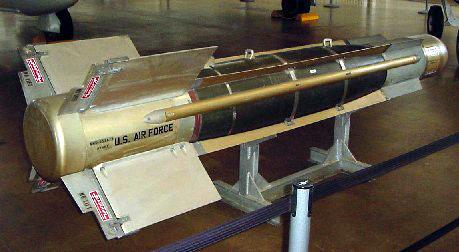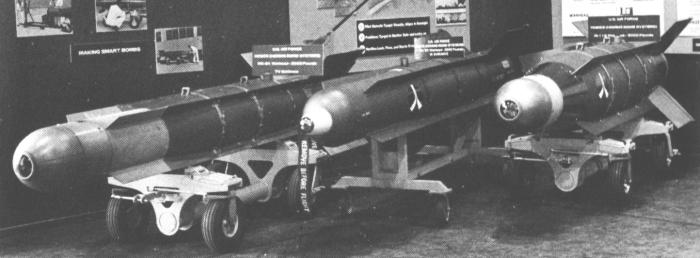Rockwell HOBOS (Homing Bomb System)
(GBU-8/B, GBU-9/B)
In 1967 Rockwell received a U.S. Air Force contract to develop an electro-optical guidance kit for the 2000 lb MK 84 bomb. The system, which became known as HOBOS (Homing Bomb System), was evaluated by F-4 Phantom units in combat in Vietnam in 1969. A HOBOS kit consisted of a nose section with the black&white TV camera and seeker electronics, strakes along the bomb body, and four cruciform tailfins with flying surfaces to control the EOGB (Electro-Optically Guided Bomb). The delivery aircraft's pilot and WSO (Weapon System Officer) had to manoeuver the aircraft to align the seeker with a target, while the WSO watched a TV screen with the camera's image. When the TV screen's center "gate" was on a target of sufficiently high image contrast, the WSO could lock the seeker. After lock-on, the bomb was released and was guided by the seeker logic toward the target.
 |
| Photo: Hill Aerospace Museum |
| GBU-8/B |
The HOBOS guidance kits included the KMU-353( )/B and KMU-390/B with image contrast seekers, and the KMU-359/B with an IIR (Imaging Infrared) seeker. The latter presumably was to be used for night-time attacks. The following table lists all known HOBOS configurations:
| Designation | Warhead | Modification Kit |
|---|---|---|
| — 1 | BLU-89/B or BLU-90/B | KMU-353/B |
| GBU-8/B | MK 84 | KMU-353A/B |
| — 2 | KMU-359/B | |
| GBU-9/B | M118 | KMU-390/B |
Notes:
- There is unconfirmed information that BLU-89/B and BLU-90/B fragmentation bombs were fitted with KMU-353/B HOBOS kits, and referred to as GBU-4/B and GBU-5/B, respectively. However, while KMU-353/B kits may or may not have been tested on BLU-89/90 bombs, at least the GBU-5/B designation is most probably in error. GBU-5/B most likely referred to a "Rockeye" cluster bomb with a Paveway I LGB guidance kit.
- It is possible that the MK 84 with a KMU-359/B IIR guidance kit was referred to as GBU-8A/B.
 |
| Photo: via Jane's |
| From left: GBU-8/B, MK 84 + KMU-359/B, GBU-9/B |
Compared to the Paveway I laser-guided bombs (LGBs), the HOBOS EOGBs had the advantage that they were fully autonomous "fire-and-forget" weapons (no external support like the laser illuminators for the LGBs was necessary). However, this advantage was more than made up by the much higher cost of the EOGB kits, the necessary modifications to the delivery aircraft, and the limitation to high-contrast targets. Furthermore, the image contrast seeker technology of the time was imperfect, and on average the HOBOS bombs were less reliable and accurate than the LGBs. The USAF acquired about 4000 KMU-353A/B kits, and dropped about 700 GBU-8/Bs during the Vietnam war. This represented the vast majority of HOBOS bombs produced, because the KMU-359/B and KMU-390/B kits were built in small numbers only.
Although the HOBOS system itself was not very successful, it formed the base of the much improved MGWS (Modular Guided Weapon System) family of TV- and IIR-guided glide bombs.
Specifications
Note: Data given by several sources show slight variations. Figures given below may therefore be inaccurate!
Data for GBU-8/B, GBU-9/B:
| GBU-8/B | GBU-9/B | |
|---|---|---|
| Length | 3.63 m (11 ft 11 in) | 3.66 m (12 ft) |
| Diameter | 46 cm (18 in) | 63.5 cm (25 in) |
| Fin span | 1.12 m (3 ft 8 in) | 1.35 m (4 ft 5 in) |
| Weight | 1027 kg (2264 lb) | ? |
| Warhead | MK 84 bomb | M118 bomb |
Main Sources
[1] R.T. Pretty: "Jane's Weapon Systems 1977", Jane's, 1976
[2] National Museum of the U.S. Air Force Website
[3] ORDATA Online Website
Back to Directory of U.S. Military Rockets and Missiles, Appendix 5
Last Updated: 11 May 2006